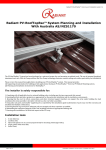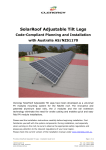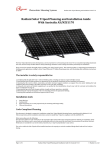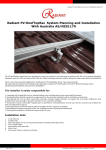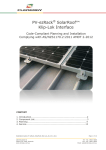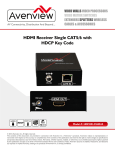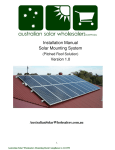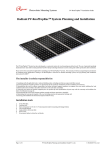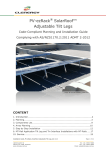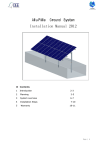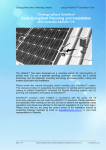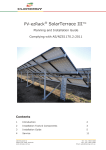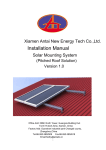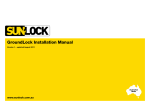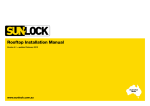Download Installation Manual - Pivotal Solar Solutions
Transcript
RADIANT SOLAR TRIPOD™ PLANNING AND INSTALLATION GUIDE v1.1 Radiant Solar Tripod™ Planning and Installation Guide V1.1 With Australia AS/NZS1170.2 The Solar Tripod™ System has been developed as a universal system for roof-mounting on flat roofs. The use of patented (pending) aluminium base rails, Click-In Clamp and Base Rail Pre-Clamp technology eliminates custom cutting and enables particularly fast installation. Please review this manual thoroughly before installing your Solar Tripod™ system. This manual provides: (1) Supporting documentation for building permit applications relating to Solar Tripod™ Universal PV Module Mounting system. (2) Planning and installation instructions for Solar Tripod™. The installer is solely responsible for: 1. Complying with all applicable local or national building codes, including any that may supersede this manual; 2. Ensuring that Rack and other products are appropriate for the particular installation and the installation environment; 3. Ensuring that the roof, its rafters, connections, and other structural support members can support the array under building live load conditions (this total assembly is hereafter referred to as the roof rafter assembly); 4. Using only rack parts and installer-supplied parts as specified by Rack (substitution of parts may void the warranty and invalidate the Radiant certification); 5. Ensuring that the leg screws have adequate pull out strength and shear capacities as installed; 6. Maintaining the waterproof integrity of the roof, including selection of appropriate flashing; and 7. Ensuring safe installation of all electrical aspects of the PV array. Installation tools 1. 2. 3. 4. 5. 6mm allen key; Cordless drill; Plain end screwdriver; Power Cord; Adjustable Spanner. Page 1 of 10 Solar Tripod™ installation manual-Version 1.1 (updated Dec 2012) RADIANT SOLAR TRIPOD™ PLANNING AND INSTALLATION GUIDE v1.1 Code-Compliant Planning This document is designed to support for installations using Solar Tripod™ mounting System, manufactured by Radiant Co. Ltd. Follow steps below and the installation instructions section to install Solar Tripod™ in compliance with the AS/NZS1170.2. Before proceeding, note the following: This document addresses only wind loads on the assumption that wind produces the maximum load factor affecting an installation. Verify that other local factors, such as snow loads and earth quake effects, do not exceed the wind loads. Give precedence to any factor that does. Wind loads are considered to act on the entire projected area, or may be perpendicular to any surface. The roof on which the Solar Tripod™ will be installed must have the capacity to resist the combined Design Dead Load and Live Load per footing. 1. Determine the wind region of your installation site Region Definition: Wind regions are pre-defined for all of Australia by Australian Standard 1170. The Wind Region has nothing to do with surrounding topography or buildings. Most of Australia is designated Region A which indicates a Regional Ultimate Basic Wind Velocity of 45meter / per sec. Some areas are designated Region B (57meter / per sec). Local authorities will advise if this applies in your area. Region C areas (66meters / per sec) are generally referred to as Cyclonic and are generally limited to northern coastal areas. Most Region C zones end 100km inland. Region D (80meters / per sec) is Australia's worst Cyclonic Region between Carnarvon and Pardoo in Western Australia. 2. Determine the height of the of your installation site This document provides sufficient information for Solar Tripod™ system installation height less than 20 meters. If your installation site is more than 20 meters in height, please contact Radiant to obtain engineering data to support your installation. Page 2 of 10 Solar Tripod™ installation manual-Version 1.1 (updated Dec 2012) RADIANT SOLAR TRIPOD™ PLANNING AND INSTALLATION GUIDE v1.1 3. Determine the Maximum Rail Support Spacing Please use the following table to determine the Base Rail40 support spacing for flat roof installations timber purlin screws. This applies to the tripod being installed flat, or with appropriate Radiant lifting legs, or klip lok clamps (see p.5). MAXIMUM SOLAR TRIPOD™ IN mm FOR TIMBER BATTENS / PURLINS ROOF ZONE Internal Zone Edge Zone Installation Height 5 Meters 10 Meters 15 Meters 20 Meters 5 Meters 10 Meters 15 Meters 20 Meters Region A & B (mm) 1325 1200 1160 1100 660 600 680 550 Region C (mm) 780 730 680 640 390 365 340 320 The above figures are based on modules lengths of up to 2000mm, maximum weight of 29Kg 2000mm modules requires 2 rails with fixing as per table above The above spacing applies for fixing through thin sheet purlins (greater than 1.0mm thickness) or a minimum embedment of 50mm into timber purlins. Solar Tripod™ system should be fixed to the purlins under using 2 x 14G self-drilling screws, The above figures are based on modules lengths of up to 2000mm, maximum weight of 29Kg Installation degree from 10 degree to 45 degree Please use the following table to determine the Base Rail 40 support spacing for flat roof installations using steel purlin screws. This applies to the tripod being installed flat, or with appropriate Radiant lifting legs, or klip lok clamps (see p.5). MAXIMUM SOLAR TRIPOD™ IN mm FOR STEEL BATTENS/PURLINS ROOF ZONE Internal Zone Edge Zone Installation Height 5 Meters 10 Meters 15 Meters 20 Meters 5 Meters 10 Meters 15 Meters 20 Meters Region A & B (mm) 1250 1150 1100 1000 630 570 550 500 Region C (mm) 730 680 650 600 360 340 320 300 2000mm modules requires 2 rails with fixing as per table above The above spacing applies for fixing through thin sheet purlins (greater than 1.0mm thickness) or a minimum embedment of 50mm into timber purlins. Solar Tripod™ system should be fixed to the purlins under using 2 x 14G self-drilling screws, The above figures are based on modules lengths of up to 2000mm, maximum weight of 29Kg Installation degree from 10 degree to 45 degree 4. Verify Acceptable Rail End Overhang Rail End Overhang must equal 1/3 or less of foot spacing. Thus, if foot spacing is 1500mm, the Rail End Over hang can be up to 500mm. In this case, two feet can support a rail of as much as 2500mm (1500mm between the feet and 500mm of overhang at each end). Page 3 of 10 Solar Tripod™ installation manual-Version 1.1 (updated Dec 2012) RADIANT SOLAR TRIPOD™ PLANNING AND INSTALLATION GUIDE v1.1 5. Determine Roof slope Solar Tripod™ system can be used for roof slope up to 60 degrees. Please verify the Installation site roof slope should be between 0 degrees and 60 degrees. 6. Determine Roof Installation Roof Areas A typical procedure in calculating the maximum building height for the installation of solar panel is given above .If you know the building height, terrain category, wind region and roof pitch, and then you can determine the edge distance as well. A roof can be divided into two zones, the internal zone and the edge zone. The width of these outer zones can be determined based on the length, width and average height of the building. If fixings are located in the internal or edge zones, then the maximum spacing to the next fixing must be reduced, as per the table above. Page 4 of 10 Solar Tripod™ installation manual-Version 1.1 (updated Dec 2012) RADIANT SOLAR TRIPOD™ PLANNING AND INSTALLATION GUIDE v1.1 Solar Tripod™ Components for Flat Roof Installation *Both Klip Lok Clamps and Lifting Leg options are for Radiant Solar Tripod installation. Two per a tripod and are required to install at set rail support spacing found on page 3. Radiant certified Klip Lok clamps include: Lysaght 700, 700, Lysaght 406, 406, & Diamond III. Installation preparation Overview of system components Planning the module area 1. Number of modules in horizontal direction x (module width + 23.5 mm) + 60 mm 2. Distance between the modules: 23.5 mm 3, Overhang: 40mm 4, Number of modules in the vertical direction x module height (please check also the installation manual of the manufacturer of the solar module) Page 5 of 10 Solar Tripod™ installation manual-Version 1.1 (updated Dec 2012) RADIANT SOLAR TRIPOD™ PLANNING AND INSTALLATION GUIDE v1.1 INSTALLATION INSTRUCTIONS SOLAR TRIPOD™ INSTALLATION 1, Unfold the Pre-Assembled Solar Tripod. 2, Enclosed inside the tripod is the back leg used for angle adjustment. Pull out the back leg to create a triangle. 3, Determine your chosen degree of angle from the adjustable back leg holes. Bolt the Solar Tripod using bolt and nut. 4, Tighten and your Solar Tripod is ready. Continue installation by deciding on your fixing system using either Ballast, Anchor Bolt, or Sheet. FIXING ON THE ROOF(BALLAST) 5A. If you are installing the Solar Tripod using a ballast weight system: Place Tripods in position and secure with determined weight ballast blocks designed to secure system to the roof. Page 6 of 10 Solar Tripod™ installation manual-Version 1.1 (updated Dec 2012) RADIANT SOLAR TRIPOD™ PLANNING AND INSTALLATION GUIDE v1.1 5B. Repeat Ballast to all Solar Tripods in each array. When you are complete you will be ready to install the rails. FIXING ON THE ROOF(ANCHOR BOLT) 6A. Fix Tripod with Anchor Bolt to the concrete roof. Solar Tripod has two predetermined holes for bolt insertion. 6B. Repeat Anchor Bolt installation to all Solar Tripods in each array. When you are complete you will be ready to install the rails. FIXING ON THE ROOF(SHEET ROOF) 7A. Position Solar Tripods parallel or across the sheet purlins. Using wood screws, attach the Solar Tripod using 2 screws. If applicable, installer can use 2 x klip lok clamps, or 2 x lifting legs, to attach between tripod and appropriate profiled roof. 7B. Repeat sheet installation to all Solar Tripods in each array. When you are complete you will be ready to install the rails. BASE RAIL INSTALLATION Page 7 of 10 Solar Tripod™ installation manual-Version 1.1 (updated Dec 2012) RADIANT SOLAR TRIPOD™ PLANNING AND INSTALLATION GUIDE v1.1 8. When Tripods are all aligned and secured to the roof, simply slide the rail down until rail ‘clicks’ into the preassembled rail clips. 9. Using a cordless drill, tighten the rail clips to firmly tighten the rails into place. 10. Ensure to insert splice (joiners) underneath rail to connect long arrays. 11. Tighten using Allen Key. WIND CROSS SET INSTALLATION 12. To finish the racking installation, and ensure the system is secure, assemble the wind cross set at the back of Solar Tripod system. Page 8 of 10 Solar Tripod™ installation manual-Version 1.1 (updated Dec 2012) RADIANT SOLAR TRIPOD™ PLANNING AND INSTALLATION GUIDE v1.1 13. Tighten the wind cross set. PV MODULES INSTALLATION 14. Place the module end clamp into the rail by entering on an angle (hooking one side of the rail) and applying pressure. 15. Layout first panel against the first end clamp. Put module middle clamp (including earthing plate) into the rails, place it firmly against the module and fasten loosely (approx. 2 - 3 turns). Now inset the next module against the previously installed module and tighten the inter-module clamp using the Allen key. (Recommended torque is 15 Nm). 16. Put rail cap into the base rail, Continue mounting the modules as described in steps 11 to 12 until all modules are installed. The installation is finished! Page 9 of 10 Solar Tripod™ installation manual-Version 1.1 (updated Dec 2012) RADIANT SOLAR TRIPOD™ PLANNING AND INSTALLATION GUIDE v1.1 15 Years Standard Warranty Terms and Conditions RADIANT International (“RADIANT”) warrants to the original purchaser (“Purchaser”) of product(s) that it manufactures (“Product”) at the original installation site that the Product shall be free from defects in material and workmanship for a period of fifteen (15) years, except for the anodized finish which shall be free from visible peeling, or cracking or chalking under normal atmospheric conditions, from the earlier of: 1). the date the installation of the Product is completed, or; 2). 30 days after the purchase of the Product by the original Purchaser. The Warranty does not apply to any foreign residue deposited on the finish. All installations in corrosive atmospheric conditions are excluded. The Warranty is VOID if the practices specified by AAMA 609 & 610-02 – “Cleaning and Maintenance for Architecturally Finished Aluminium” (www.aamanet.org) are not followed by Purchaser. This Warranty does not cover damage to the Product that occurs during its shipment, storage, or installation. This Warranty shall be VOID if installation of the Product is not performed in accordance with RADIANT’s written installation instructions, or if the Product has been modified, repaired, or reworked in a manner not previously authorized by RADIANT IN WRITING, or if the Product is installed in an environment for which it was not designed. RADIANT shall not be liable for consequential, contingent or incidental damages arising out of the use of the Product by Purchaser under any circumstances. If within the specified Warranty periods the Product shall be reasonably proven to be defective, then RADIANT shall repair or replace the defective Product, or any part thereof, in RADIANT’s sole discretion. Such repair or replacement shall completely satisfy and discharge all of RADIANT’s liability with respect to this Limited Warranty. Under no circumstances shall RADIANT be liable for special, indirect or consequential damages arising out of or related to use by Purchaser of the Product. Manufacturers of related items, such as PV modules and flashings, may provide written warranties of their own. RADIANT’s Limited Warranty covers only its Product, and not any related items. Page 10 of 10 Solar Tripod™ installation manual-Version 1.1 (updated Dec 2012)










